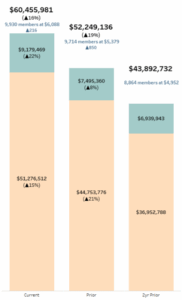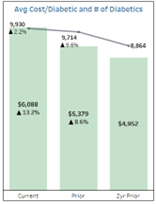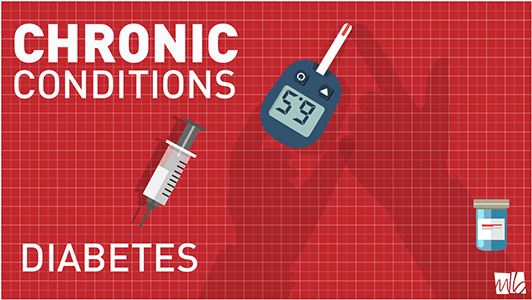Type 2 diabetes is a widespread health issue in the U.S., affecting a significant portion of the adult population and leading to substantial healthcare costs. Its prevention, early detection and management are critical to reducing costs for employers.
PREVALENCE – As of 2024, 1 in 7 adults in the U.S. is affected by type 2 diabetes. This equates to over 53 million adults affected – with 38 million diagnosed cases and 15 million undiagnosed cases. Each year, 1.5 million Americans are newly diagnosed with diabetes, reflecting a persistent and growing public health challenge.
Type 2 Diabetes is the most prevalent form of diabetes in the U.S.
- Type 2 diabetes accounts for approximately 91% of all diabetes cases. (2024)
- An estimated 97.6 million adults have pre-diabetes – and 90% of them don’t know it!
Associated Health Risks & Costs – Type 2 diabetes significantly increases the risk for:
- Cardiovascular disease
- Kidney failure
- Vision loss
- Nerve damage
- Amputations
COSTS CLOSE TO HOME
HOW TYPE 2 DIABETES IS AFFECTING YOUR HEALTH CARE SPEND?
McGohan Brabender diabetic members in our data analytics system accounted for $190 million dollars in spend in 2024, up $30 million from 2023, largely due to the increase of GLP-1 usage. GLP-1 receptor agonists (GLP-1s), such as Ozempic, Mounjaro, and Rybelsus, have had a transformative impact on diabetes care in the U.S.—but they also come with significant financial implications. Diabetes GLP-1 spend from our MB book of business was over $29 million for 2024, up $13 million from 2023 (82% increase).
Nationally, GLP-1s are estimated to contribute $21,758 per patient annually for those with type 2 diabetes—$7,800 more than patients not using GLP-1s. Total U.S. spending on GLP-1s rose from $13.7 billion in 2018 to $71.7 billion in 2023—a >500% increase. GLP-1s are now the top drug category by total spending and the fastest-growing segment in the pharmaceutical market. Projections suggest GLP-1 sales could reach $100 billion by 2030.
For MB clients, the condition of Diabetes alone accounted for over $60 million, with over $51 million in Rx spend in the most recent 12 months (up from nearly $45 million prior) and nearly $9.2 million on medical spend. That is 7% of total health care costs attributed to type 2 diabetes alone.
spend. That is 7% of total health care costs attributed to type 2 diabetes alone.
McGohan Brabender diabetic members are 222% more expensive per year than the average member. Diabetics have an average cost of $22,517/diabetic member per year (vs an average for all members of $6,996/member).
For McGohan Brabender clients, the average cost per diabetic patient for costs associated directly with diabetes, and not including co-morbidities, was $6,088. This is an increase of 13% in cost per patient from the prior 12-month period. There were 2.2% more members diagnosed with diabetes from the prior period, for a total of more than 9,900 members. This equates to 8% of the population diagnosed with diabetes. Additionally, there were more than 4,600 members diagnosed with pre-diabetes, up 15% from the prior period.


![]()
ARE YOUR MEMBERS AT RISK? WHAT CAN YOU DO?
DON’T SKIMP ON PREVENTIVE CARE – Like many chronic conditions, type 2 diabetes is largely preventable through evidence-based lifestyle interventions and early detection. Effective strategies include:
- Early screening and intervention with an annual exam and blood work to determine your risk
- Healthy diet and eating habits
- Regular physical activity and weight management
WARNING SIGN – DANGER AHEAD
Type 2 diabetes, if caught early, can often be prevented. Prediabetes is a condition in which your blood sugar is above the normal range, but not yet high enough to be considered diabetes. This is your warning sign – DANGER AHEAD. And this is where it needs to be caught! Prediabetes is an indication that you could develop type 2 diabetes if you don’t make some lifestyle changes. Nearly 98 million American adults have prediabetes, and 90 percent of them don’t know it. Get your annual exam and know your numbers:
- Fasting blood sugar level from 100 to 125 is considered prediabetes
- Fasting blood sugar level of 126 or higher indicates type 2 diabetes
People with prediabetes who make a lifestyle change —such as improving their diet, increasing physical activity, and losing a modest amount of weight— can cut their risk of developing type 2 diabetes by as much as 58%.
For employers, ensuring your members have an annual physical with their primary care physician is a first step in catching many chronic conditions including diabetes, before they become permanent. Ask your McGohan Brabender account manager about the best ways to implement this idea.
Written by: Kelly McCall, Manager Health Intelligence Analytics

